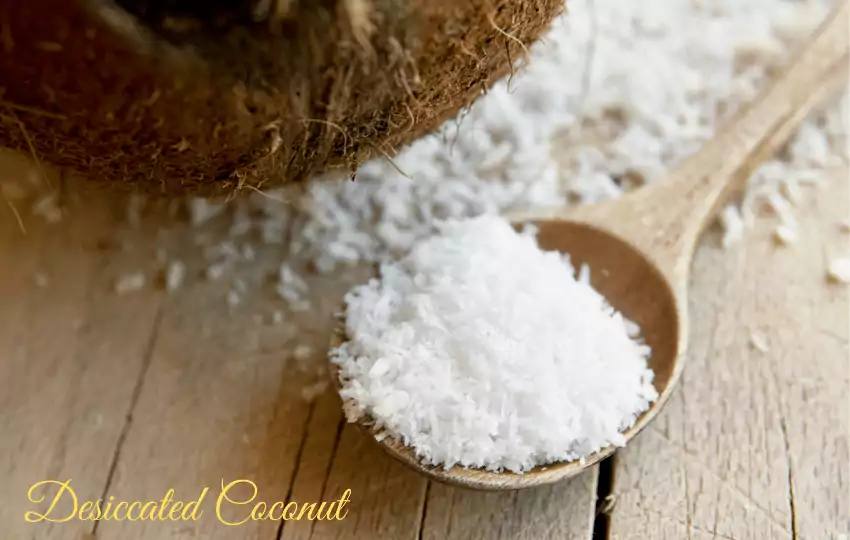Desiccated Coconut is popular because of its many applications, but what if you can’t find it at the right time?
No worries, since I collect seven readily accessible desiccated coconut substitutes that are nearly identical in taste and texture.
Give your recipe the exact flavor you’d expect from desiccated coconut.
However, some adjustments are required, so continue reading and scroll down for suggestions that will delight your taste buds!
What do you get from these Alternatives here?
- 7 best Desiccated Coconut substitutes
- All are Pantry staples so you don’t need to go anywhere
- Easily use and don’t change the final result
- I have details on how to use it or how much you swap
Before jumping to the substituting part, I would discuss a little detail about Desiccated Coconut and most importantly how to choose the alternatives.
Or, you can check the names below the box…
Best Substitute for Desiccated Coconut are - Shredded coconut, Coconut flour, Dried Coconut, Dried fruits, Coconut Milk Powder, Fresh Grated Coconut, Coconut Flakes.
What is a Desiccated Coconut? What does it taste like?
Desiccated coconut is not the same as fresh shredded coconut. Desiccated Coconut comes in dried form and is used in many Indian dishes such as curries, sweets, and desserts.
The desiccated coconut we get in most grocery stores looks like white flakes or powder, and it tastes similar to regular fresh grated coconut, only slightly drier or moister.
Things To Remember While Choosing A Substitution For Desiccated Coconut
- Consider the texture and flavor of the ingredient you’re replacing
- Pay attention to what recipe you are preparing
- For a vegan-friendly substitute, nut butter works well in most dishes.
- Comparisons of the attributes of each ingredient are used to determine which substitute will produce the closest results while still providing a delicious experience in meals and snacks.
7 Similar Desiccated Coconut Alternatives
1. SHREDDED COCONUT
Shredded coconut is the process of making dried shredded flesh of mature coconuts by scraping it off and drying it in the sun or oven.
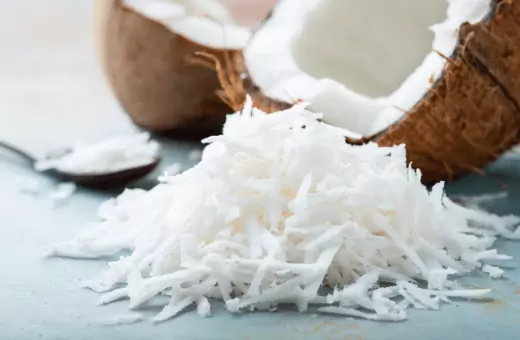
Shredded coconut is different from desiccated coconut but can be used best substitute.
How much Use- 2 Cup Desiccated= 1 Shredded Coconut
The Shredded coconut has been defatted and then dried, whereas desiccated coconut is dried by itself. It has high moisture content and is sweet in taste.
You can add Shredded coconut to several desserts, baked goods, sweets, etc. Also used as an ingredient for milk-based or juice beverages along with nuts, raisins, or chocolate chips. Coconut flakes are thin slices of coconut meat.
[amazon box=”B08CKVXQJ3″]
2. Substitute COCONUT FLOUR For Desiccated Coconut
Coconut flour is another similar form of Desiccated coconut. Coconut Flour the dried, finely-ground meat of a coconut.
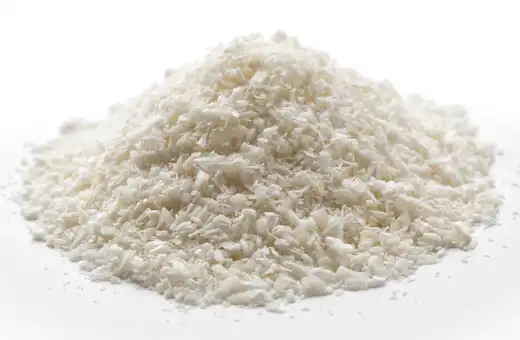
The process for extracting the oil and milk from coconuts can leave behind a dry, white/cream-colored residue called “coconut meat” or “desiccated coconut.”
This substance is then ground into a fine powder to create what is known as coconut flour.
How much Use- 1 Cup Coconut flour= 1/2 cup Desiccated Coconut
Coconut flour is gluten-free and high in fiber, making it very effective for weight loss and stabilizing blood sugar levels.
It holds a soft and moist texture and does not form into clumps as traditional flours do, so it’s best used as a thickener or to add moisture to baked goods.
3. DRIED COCONUT
Dried Coconut has a tough brownish outer skin that needs to be removed before using in recipes.
Dried coconut has a high fiber content and contains very little moisture, and has a slightly sweet, nutty taste. It can be treated as any other nut for substitution purposes in cooking.
How much use- 1:1 Ratio
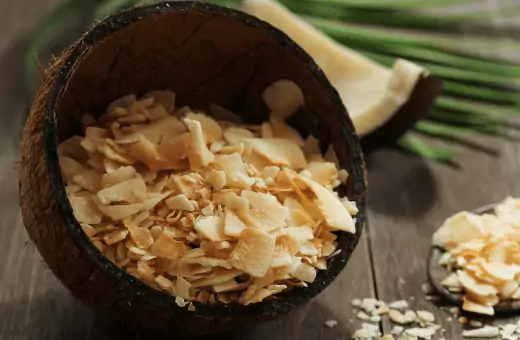
Husked dried coconut is commonly used shredded, as it melts quickly once baked or fried briefly. It can also be ground to a more delicate texture and is often made into a paste used in curries or sweets.
4. Try DRIED FRUITS instead of Desiccated Coconut
Dried fruits are the fruit that has been dehydrated or dried to remove all moisture content.
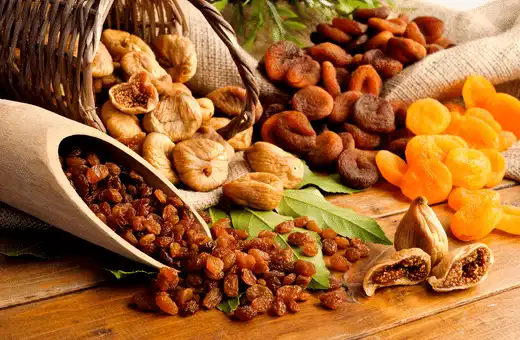
Dried fruits are packed with nutrients and are delicious to eat. They also have a longer shelf life approximated to fresh fruits.
Some of the most common dried fruits include raisins, cranberries, apricots, apples, figs, etc.
How much Use- 1 cup Desiccated Coconut = 1/2 Cup Dried Fruits
You can use dried fruits in many desserts like kheer or halwa or other sweets you like. You can even make a paste of dried fruits and add in some curry and chicken recipes. They enhance the taste of the food.
Dried fruits can absorb more water than desiccated coconut, so look after that while using them instead of desiccated coconut recipes.
5. COCONUT MILK POWDER
Coconut Milk Powder (Dry Milk Coconut Cream) is extracted from fresh, mature coconut meat. It is then dried and granulated form of coconut milk.
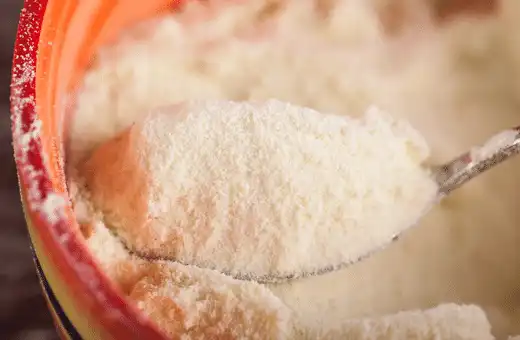
Coconut cream can make coconut ice, coconut jelly, coconut jam, etc. It will not spoil even without preservatives or refrigeration because it has more than 80% fat content.
How much Use- 1/2 Amount of Coconut Powder =1 Cup of Desiccated Coconut
Coconut Milk Powder has natural sweetness, so it does not need any additional sweetener when you use it for cooking. It is easy to digest and low in calories.
6. FRESH GRATED COCONUT
While You Have Nothing, Simply Use Fresh Grated Coconut in Place Of Desiccated Coconut.
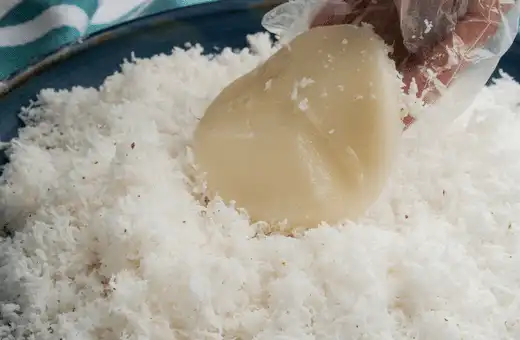
In Australia, freshly grated coconut is available in most Asian Supermarkets. Freshly grated coconut has a high moisture content because it hasn’t lost its water through the drying process.
How much Use- 1:1
Try to use freshly grated coconut instead of desiccated coconut to add coconut flavor, but not too much.
7. COCONUT FLAKES
Coconut Flakes is a product of finely ground mature coconut meat. It has a slightly sweet and delicate flavor.
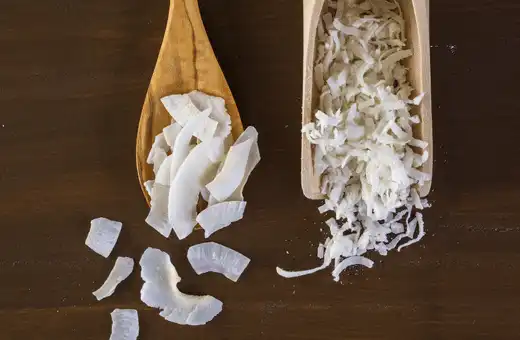
Today Coconut Flakes are primarily used as an ingredient in baking.
Use Coconut Flakes instead of Desiccated coconut in most recipes calling for it, including making curries and dishes with rice, desserts, homemade ice cream and biscuits, and so on.
How much Use- 1/2 amount
Coconut Flakes are either sweetened or unsweetened; both should be stored in airtight packages to keep them fresh and dry.
Unsweetened flakes will keep for up to six months at room temperature, while the sweeter types can be stored for up to a year.
Keep packages in the freezer for more extended storage and use them as needed.
Desiccated coconut substitute curry
To make a desiccated coconut substitute, you need to blend 1 cup of regular unsweetened coconut with 1 tablespoon of curry powder.
Curry powder is made up of different spices like cumin, coriander, fenugreek, pepper, etc.
It can be replaced with any kind of spice but is best replaced with a blend of coriander and cumin seeds.
Mix the spices with 1 teaspoon of salt and place it on a baking sheet in an oven at 130 degrees Celsius (or 266 degrees Fahrenheit) for about 20 minutes.
Stir the spice mixture every 5 minutes until it is dry and crisp. Be careful not to overbake the spice mixture; it is done when it looks dry and crispy.
Let the spices cool down for another 5 minutes before removing them from the tray.
There you are.! Your desiccated coconut substitute (or curry powder) is done, and it can be stored in an airtight jar.
This is an excellent recipe for vegans or anyone who can’t eat dairy. The desiccated coconut substitute has just the right amount of taste and leaves you feeling full and satisfied.
Check More- Coconut milk substitute for curry
Substitute for desiccated coconut in the baking
On some Lebanese blog sites, I’ve seen that they used either shredded coconut or almond meal for this purpose.
You can also use shredded coconut, which I believe will add a nice flavor to your dish.
There is, however, a big difference when you substitute desiccated coconut with almond meal or shredded coconut in baking recipes.
If you replace one cup of desiccated coconut with 1/2 cup of almond meal and 1/2 cup of shredded coconut, it will change the original texture and taste.
You can use almond meals instead of desiccated coconut in most desserts like cakes and muffins but not in some pastries that require a crunchy crust like macaroons, baklava, or shortbread cookies (financiers).
In this case, the almond meal will make the pastry soft and chewy.
You can also try using part of the almond meal and shredded coconut in a recipe that requires desiccated coconut.
I tried a recipe for Greek cake with orange zest, which required 1 cup of desiccated coconut, and substituted half of it with almond meal and half of it with shredded coconut.
It was a little crunchy outside but soft inside; the only thing I missed was the super fine texture that desiccated coconut gives to some pastries or desserts like cakes and macaroons.
[amazon box=”B01N5UPTZS” rating=”4.7″]
What are the pros and cons of using a substitute in place of desiccated coconut?
In general, a substitute replaces another ingredient in cooking because of food allergies or dietary restrictions.
The substitute may be used to lower the fat or caloric content of a recipe, use up an ingredient that is currently in the pantry, or reduce costs by using more readily available ingredients.
For example, almond or rice milk can be used to substitute regular milk in many recipes.
Substitute ingredients may also have different cooking properties than the original, which may affect the outcome of your recipe.
For example, goat cheese has a slightly tangier flavor than ricotta, so replacing ricotta with goat cheese in lasagna may alter the taste of your dish.
When substituting ingredients, you should always use components of a similar consistency, which means you may need to alter the amount of liquid in the recipe.
For example, make chocolate chip cookies with buttermilk and want to change the buttermilk to regular milk. You should add more flour or another thickening agent because buttermilk has lower fat content than regular milk.
The basic rule of cooking is that it always pays to use the exact ingredients called for in a recipe.
However, there are many times that you might not have all of the ingredients at hand, or you may simply want to try something new. In these cases, it is acceptable to use a substitute.
If you don’t have one of the ingredients on hand, that’s okay!
[amazon box=”B00TH8EK34″ rating=”4.9″]
When are the best times to substitute instead of desiccated coconut flakes/flour?
When you want to add moisture and/or flavor to a recipe.
How to make desiccated coconut from shredded coconut?
Using a sharp, heavy knife, cut the coconut meat along its natural seams into 3 or 4 portions. Remove the thin brown skin from each portion.
In a food processor, one portion at a time, pulse the coconut meat until it becomes shredded.
You don’t want to over-process the coconut, so keep an eye on it. When the coconut is shredded, take it out of the processor bowl and repeat with the remaining portions until all have been processed.
Three cups of unsweetened coconut will make about 2 1/2 cups of desiccated coconut.
How to Make desiccated coconut without oven
Many people don’t like to use dehydrated, desiccated coconut in their cooking recipes.
They may find it challenging to get desiccated coconut, so they can easily make this desiccated coconut at home without an oven.
You will get a clear idea of how you can make it at home by reading the below-given steps.
How to make desiccated coconut without an oven?-Take a cup of freshly grated coconut and spread it on a flat plate or dish.
Prefer to use tender coconut for this desiccated coconut recipe.
Let the grated coconut dry for around two hours on medium heat at room temperature or sun-dried for almost half an hour.
After two hours, take the grated coconut in a blender jar or processor bowl.
Add half a teaspoon of salt and process it for a few seconds or till it becomes a bit fine.
Now spread this mixture on a plastic sheet and dry at room temperature for an hour or two.
In the end, you will get the nice desiccated coconut lump from this mixture.
It can be kept in a dry bottle or jar. You can use this in your cooking recipes to get delicious recipes. You can keep it for one month at room temperature.
Note: You can store this desiccated coconut mixture in the freezer also to make it for one month. Remember that you should not use this coconut in the cooking recipe if using pampered in the freezer.
Can I substitute desiccated coconut for shredded coconut?
Of course, you can! Desiccated coconut is usually made from dried, shredded coconut.
It has a longer shelf-life because the shreds are thinner and more dehydrated; they won’t go bad as quickly as full-size shreds.
You can use desiccated coconut anywhere you usually use regular shredded coconut: in baking, raw recipes, or even to top a pie or ice cream.
How to use desiccated coconut!
Desiccated coconut is regular coconut meat, shredded or ground.
It is used in many recipes for its unique texture and flavor. It has a high oil content; it is challenging to keep it after mixing with other ingredients. So it should be added as required.
Desiccated coconut is used in many recipes. It gives a unique flavor to the dishes.
1. Desiccated coconut is used for garnishing desserts or other dishes. It can be consumed as it is or can be mixed with fruits to make a filling dessert.
2. Desiccated coconut along with coconut milk is used in making curry. It is used for both vegetarian dishes and non-vegetarian dishes.
3. Desiccated coconut is used in making chutneys, a side dish for rice dishes.
4. Desiccated coconut is used in making sweets like Mysore Pak and many other sweets.
5. Desiccated coconut is used in making many other dishes like kheer, halwa, etc. Desiccated coconut is also used for garnishing purposes.
6. Desiccated coconut is a good substitute for fresh coconut meat in curries or soups, where the texture and flavor of fresh coconut would otherwise be very noticeable.
Read More- Best Corn Oil Replacements for Carrot Cake
Is desiccated coconut the same as shredded coconut?
No. They are two different products. Desiccated coconut is a dried coconut with most of the oil pressed out of it, resulting in fine, dry flakes.
Shredded coconut is made from ground dried coconut meat.
My Favourite Desiccated Coconut Replacements
· Shredded Coconut
· Freshly Grated Coconut
· Dried Fruits
· Dried Coconut
Wrap Up On Substitutes for Desiccated Coconut
I expect you enjoyed reading this article and found it helpful in searching for a substitute for Desiccated Coconut.
Please leave me a comment on which replacement of Desiccated Coconut you like the most.
If any alternates are not mentioned in this list, please mention them below and share your favorite one with us.
Read More- Coconut Soda Substitutes
FAQs Related To Desiccated Coconut & Its Alternatives
Q1. Can I substitute desiccated coconut for an almond meal?
Almond meal is not the same as desiccated coconut. Almond meal is made of blanched almonds that are ground into flour.
Desiccated coconut is toasted and then crumbled, which gives it a light golden color.
You may use Desiccated coconut for an almond meal in bread, cakes, cookies, and cupcakes.
If you want to substitute desiccated coconut for almond meal, the amount used should be the same as the almond meal.
Q2. Can I eat desiccated coconut?
You bet the taste buds you can. It’s still rich in fat and has a tasty, sweet flavor.
In the United States, desiccated coconut is most often used in shredded coconut recipes. However, in other countries, it is more often used in recipes that require coconut meat.
Because desiccated coconut is dried out and has its husk removed, it takes less time and energy to process.
Q3. How to toast desiccated coconut?
Toasting coconut is very simple. Toasting coconut starts with adding it to a dry skillet on medium heat.
Keep stirring until you start smelling the distinct sweet and nutty aroma.
Be careful not to burn it as it can quickly go from toasted to burned.
Once you have reached your desired brownness, immediately remove it from the stove and transfer the coconut to a bowl.
Q4. Desiccated unsweetened coconut
Desiccated unsweetened coconut is an excellent source of fiber and healthy fats. These keto-friendly chips can be flavored to your liking and make a perfect low-carb snack!
Desiccated unsweetened coconut has high fiber content, so they digest slowly and don’t spike blood sugar levels. After you taste how sweet they are, you’ll agree that there’s no better option.

